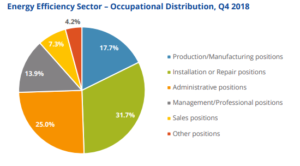Efficiency Retrofits Drive Clean Energy Jobs
Demand for energy efficient technology and building retrofits has driven job growth across many U.S. industries. Energy efficiency job growth rose 3.4 percent in 2018, according to the 2019 U.S. Energy and Employment Report. This critical sector of the economy includes jobs in construction, manufacturing, wholesale trading, engineering, and more.
Energy Efficiency Jobs by the Numbers
- 3 million Americans work in energy efficiency jobs in the U.S.
- In 2018, the energy efficiency sector produced the most NEW jobs of any energy sector—more than 76,000.
- Energy efficiency jobs are predicted to grow the most of any energy sector—7.8 percent in 2019, with construction job grow expected to be at 8.8 percent.
- 1 in 5 workers in the energy efficiency sector in 2018 worked in professional or business services.
- More than 321,500, 13 percent, of energy efficiency workers in 2018 were in manufacturing.
With nearly 200,000 new energy efficiency jobs expected in 2019, the sector is having difficulty filling key positions such as technicians and mechanical support, sales, marketing and customer service, and even engineers and scientists.
More than 70 percent of energy efficiency employers in all industries reported at least some difficulty in hiring in 2018. The construction industry reported the single highest degree of difficulty, especially for electricians and laborers. Some 82 percent of professional and business employers in energy efficiency reported it was either somewhat or very difficult to hire new employees, and 72 percent of manufacturing employers reported the same. Lack of experience, training, and technical skills were the most common reasons for hiring deficiencies.
As demand for energy efficient technologies and materials grows, so does the economic impact of the efficiency sector. Done correctly, energy efficiency investments can power local economies, support domestic manufacturers, and offer good jobs that pay livable wages.
In addition to direct jobs, consumers and businesses recirculate the money saved through lower energy bills, creating a multiplier effect downstream that generates positive economic outcomes for other sectors of the economy.
Energy Star appliances—including high-efficiency heating and cooling equipment—was the largest category of employment in the energy efficiency sector, employing just over a quarter of the energy efficiency workforce in 2018. The second largest category of employment was the traditional HVAC industry, with just under a quarter of the sector’s employment in 2018. The third largest category of employment was advanced building materials, followed by energy efficient lighting.

